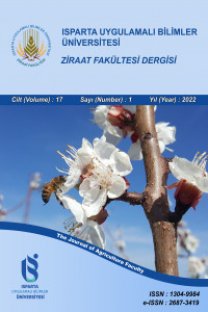Tarım Arazilerinde Bitkisel Örtü ve Ürün Yönetimi Faktörünün (C-Faktörü) Belirlenmesi ve NDVI ile İlişkisi
C-faktörü, NDVI, uzaktan algılama, jeo-istatistik.
Determination of cover management factor (C-Factor) in agricultural lands and its relationship with NDVI
C-factor, NDVI, remote sensing, geo-statistics,
___
De Jong, S.M., 1994. Derivation of vegetative variables from a Landsat TM image for modelling soil erosion. Earth Surf. Processes Landforms 19, 165–178.Durigon, V.L., Carvalho, D.F., Antunes, M.A.H., Oliveira, P.T.S. and Fernandes, M.M. 2014. NDVI time series for monitoring RUSLE cover management factor in a tropical watershed. International Journal of Remote Sensing, 2014 Vol. 35, No. 2,441–453, http://dx.doi.org/10.1080/01431161.2013.871081.
Gabriels D, Ghekiere G, Schiettecatte W, Rottiers I. 2003.Assessments of USLE cover management C factors for 40crop rotation systems on arable farms in the Kemmelbeek watershed, Belgium. Soil Tillage Research, 74, 47–53.
Karaburun A. 2010. Estimation of C factor for soil erosion modeling using NDVI in Buyukcemece watershed. Ozean Journal of Applied Sciences, 3, 77–85.
Lu H, Prosser I P, Moran C J, Gallant J C, Priestley G, Stevenson J G. 2003. Predicting sheet wash and rill erosion over the Australian Continent. Australia Journal of Soil Research, 41, 1037–1062.
Meusburger, K., D. Bänninger, and C. Alewell. 2010. “Estimating Vegetation Parameter for Soil Erosion Assessment in an Alpine Catchment by Means Of QuickBird Imagery.” International Journal of Applied Earth Observation and Geoinformation 12: 201–207.
Morgan, R. P. C. 2005. Soil Erosion and Conservation. Malden-MA-USA. 3rd ed. Oxford: Resources Institute, Granfield University, Blackwell.
Panagos, P., Borelli, B., Meusburger, K., Alewell, C., Lugato, E., Montanarella, L. 2015. Estimating the soil erosion cover-management factor at the European scale. Land Use Policy 48 (2015) 38–50. http://dx.doi.org/10.1016/j.landusepol.2015.05.021.
Patil, R. J. and Sensing S. K. GIS based modeling ofcrop/cover management factor (C) of USLE in Shakker river watershed. International Conference on Chemical, Agricultural and Medical Sciences (CAMS-2013) Dec. 29-30, 2013 Kuala Lumpur (Malaysia). http://dx.doi.org/10.15242/IICBE.C1213023.
Renard, K.G., C.R. Foster, G.A. Weesies, D.K. McCool, and D.C. Yoder, 1997. Predicting Soil Erosion by Water: A Guide to Conservation Planning with the Revised Universal Soil Loss Equation (RUSLE), USDA, Agriculture Handbook Number 703, Government Printing Office, Washington, D.C., 404 p.
Schönbrodt S, Saumer P, Behrens T, Seeber C, Scholten T.2010. Assessing the USLE crop and management factor Cfor soil erosion modeling in a large mountainous watershedin central China. Journal of Earth Science, 21, 835–845.
Suriyaprasita, M. and Shrestha, D. P. 2008. Deriving Land Use and Canopy Cover Factor from Remote Sensing and Field Data in Inaccessible Mountainous Terrain for Use in Soil Erosion Modelling. The International Archives of the Photogrammetry, Remote Sensing and Spatial Information Sciences. Vol. XXXVII. Part B7. Beijing 2008. Technical Session TS-34:SS-7 Global Monitoring For Environment and Security (GMES).
Ustin, S. L., M. O. Smith, S. Jacquemoud, M. Verstraete, and Y. Govaerts. 1999. “Geobotany: Vegetation Mapping for Earth Sciences.” In Remote Sensing for the Earth Sciences, edited by A. N. Rencz, 251–307. New York: John Wiley and Sons.
Van der Knijff, J. M., R. J. A. Jones, and L. Montanarella. 2000. Soil Erosion Risk Assessment in Europe. Ispra: European Soil Bureau. Joint Research Centre. EUR 19044 EN.
Wischmeier, W.H., and D.D. Smith, 1978. Predicting Rainfall Ero- sion Loss: A Guide to Conservation Planning, USDA, Agricul- ture Handbook Number 537, Government Printing Office, Washington, D.C., 58 p.
Zhou, P., O. Luukkanen, T. Tokola, and J. Nieminen. 2008. “Effect of Vegetation Cover on Soil Erosion in a Mountainous Watershed.” Catena 75: 319–325.
- ISSN: 1304-9984
- Yayın Aralığı: Yılda 2 Sayı
- Başlangıç: 2006
- Yayıncı: Isparta Uygulamalı Bilimler Üniversitesi
Leonardit Uygulamasının Nitrifikasyon ve Nitrat Amonifikasyonu Üzerindeki Etkisi
Hesna Rüveyda AYDIN, Fatih KURAL, Abdullah ARIN, Cennet YAYLACI, Ali COŞKAN
Alanya Yöresi Muz Bahçelerinin Beslenme Durumlarının Belirlenmesi
İbrahim ERDAL, Merve DURNAOĞULLARI
Assessment of Water Usage and Consumption of Livestock Enterprises in Bursa Region
Berkant ÖDEMİŞ, Derya KAZGÖZ CANDEMİR, Kerem KARAZİNCİR
Arazi Toplulaştırma Projelerinde Yol Uzunluklarının Analizi: Şanlıurfa Türkeli Köyü Örneği
Hamza KUZU, Fırat ARSLAN, Hasan DEĞİRMENCİ
Yeşim BOZKURT ÇOLAK, Attila YAZAR, Serpil TANGOLAR, Gülşen DURAKTEKİN, Engin GÖNEN
The Implementation of Float Tray System Technology for Production of Tobacco
Romina KABRANOVA, Karolina KOCHOSKA, Robin MAVROSKI
Ayçiçeği Spektral Özelliklerinin Yetişme Dönemi Boyunca Değişiminin Değerlendirilmesi
Emre TUNCA, Eyüp Selim KÖKSAL, Sakine ÇETİN, Nazmi Mert EKİZ, Ufuk ÇOBAN, Hamadou BALDE
